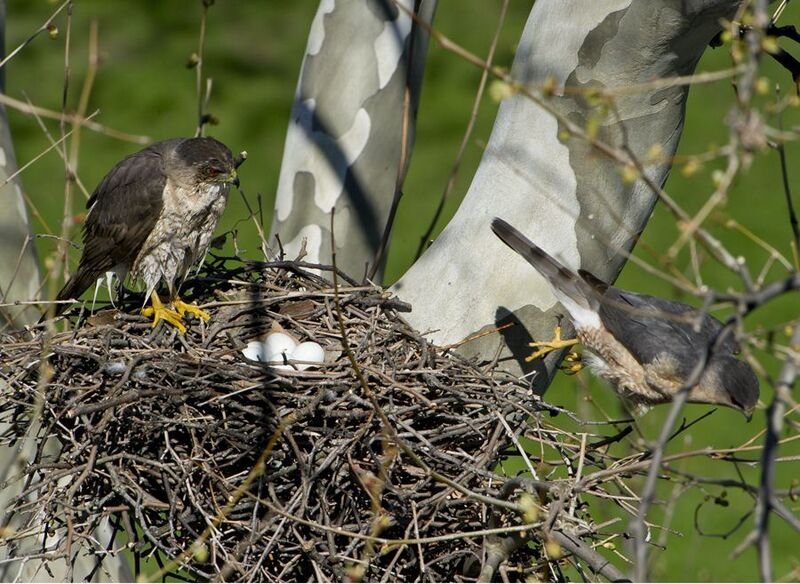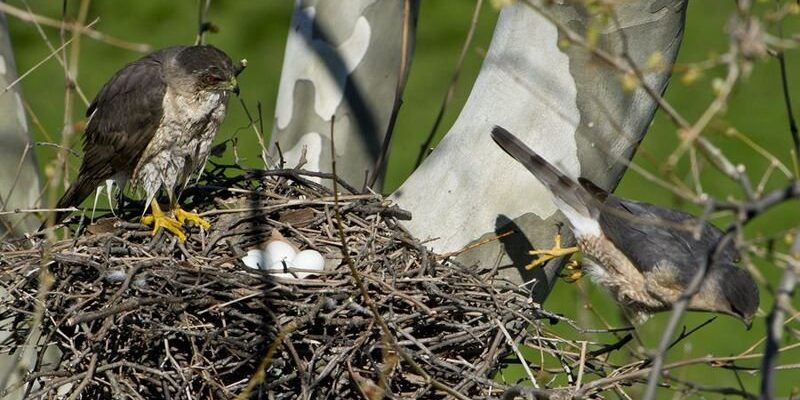
When we think about birds of prey, we often picture them making dramatic dives or perched majestically on a branch. But how do they go about building their homes and nurturing their chicks? Just like we need a comfortable nest to feel safe and secure, Cooper’s hawks have their own ways of preparing for the arrival of new life. In this article, we’ll explore their nesting habits, the stages of their lifecycle, and some interesting tidbits that might surprise you.
Nest Building: Where It All Begins
Cooper’s hawks are known for their impressive nest-building skills, a process that starts as soon as spring rolls in. These birds usually prefer to build their nests in tall trees, like pines, oaks, or even in urban areas where they can find enough cover. They typically select sites that provide a good vantage point as well as protection from predators. This choice isn’t just for aesthetics; it’s vital for the safety of their nesting chicks.
The structure of a Cooper’s hawk nest is quite remarkable. They start with a base made of sturdy branches, and then they add smaller twigs and leaves to make it cozy. Think of it like building a solid foundation for a home, then adding decorations to make it feel cozy and inviting. The female usually takes the lead in building the nest while the male assists by bringing materials. This teamwork is essential, as it helps ensure that their future chicks will have a safe place to grow.
One fascinating aspect of their nesting behavior is their tendency to reuse nests from previous years. If a pair of Cooper’s hawks successfully raised chicks in a particular location, they might return to that same nest. This not only saves energy but also provides a familiar space that can lead to better chances of success. Making a nest is no small feat, and every little detail contributes to the health and safety of the future brood.
The Eggs: A New Beginning
Once the nest is complete, it’s time for the female Cooper’s hawk to lay her eggs. Typically, she will lay between three to six eggs, depending on her health, age, and food availability. These eggs are usually a beautiful light blue or greenish color, and they often have speckled patterns. It’s almost as if nature has painted them for a gallery!
The incubation period lasts about 30 to 36 days, and the female is dedicated to keeping the eggs warm. During this time, the male provides food for her, bringing back small birds and rodents. You might wonder why the male doesn’t help with incubation. Well, that’s just part of the division of labor in their partnership. This sharing of responsibilities is crucial, allowing the female to focus entirely on protecting and nurturing the eggs.
As the incubation progresses, the female turns the eggs regularly to ensure they develop evenly. She needs to keep them at a consistent temperature, much like how we cook a perfect soufflé—too much or too little heat can ruin it! After about a month, the chicks will begin to hatch, and the excitement in the nest is palpable, as little beaks emerge into the world.
Raising the Chicks: From Hatchlings to Fledglings
Once the chicks hatch, they are helpless and rely entirely on their parents for food and protection. At this stage, they are covered in soft down feathers and have closed eyes, which will open within a few days as they acclimate to their surroundings. The female continues to spend most of her time in the nest, keeping the chicks warm and sheltered.
The male plays a crucial role during this time, diligently hunting and bringing back food for the family. You can picture him swooping through the trees, expertly capturing prey. The chicks start eating small pieces of prey that their parents bring, and as they grow, they begin to develop their own feathers. This growth period is a magical transformation, much like a caterpillar turning into a butterfly.
As the weeks pass, the chicks become more active. They start to practice their wings and get used to their surroundings. By around five to six weeks old, they are ready to try their first flights. This phase, known as fledging, is an exciting and nerve-wracking time. Imagine them taking a leap of faith from the nest, flapping their wings wildly as they explore the world for the first time!
Post-Fledging: Life as a Young Hawk
Once the young hawks have fledged, they will continue to rely on their parents for food as they learn to hunt on their own. During this time, they may still be clumsy and unsure, often landing awkwardly on branches or getting lost in the foliage. It’s a learning curve, and while they might feel like they’re on a wild adventure, their parents are always nearby, watching and guiding them.
You might notice the parents still interacting with their fledglings, calling out to them and encouraging them to practice their skills. This is crucial for the development of their hunting abilities. The adult Cooper’s hawks will also begin to teach their young about territory—where to hunt, where to roost, and how to avoid danger.
By the end of the summer, the young hawks will be almost ready to leave their natal territory. They’ll develop the skills needed to survive on their own, hunting without assistance. This independence is a vital step in their lifecycle, as it sets the stage for finding their own mate and starting the process all over again.
Migratory Patterns: Cooper’s Hawk Movements
Interestingly, Cooper’s hawks have migratory behaviors that vary based on their geographical location. Some of these birds are permanent residents, staying in the same area throughout the year, while others migrate to take advantage of seasonal changes. For example, those living in northern regions may move south during the colder months to find food and milder temperatures.
During migrations, especially in the fall, you might see these hawks moving in groups, making their way to warmer climates. This behavior is fascinating because it shows how adaptable they are to the environment around them. It’s much like how we might change our routine in response to the seasons—just as we put on a heavier coat in winter, Cooper’s hawks find new places to nest and hunt in the changing weather.
Understanding their migratory patterns can provide us with insights into their behavior and health. For instance, if a large number of Cooper’s hawks are suddenly absent from an area, it could indicate changes in their environment. Observing their movements can help researchers and bird watchers alike keep a finger on the pulse of local ecosystems.
Challenges and Conservation Efforts
Like many wildlife species, Cooper’s hawks face various challenges that can impact their populations. Habitat destruction, climate change, and human encroachment pose significant threats. Urban development can reduce their nesting sites, while changes in food availability can make it harder for them to feed their young.
Conservation efforts are crucial in ensuring that these magnificent birds continue to thrive. Organizations are working to protect their habitats by promoting responsible land use and conservation strategies. You might be wondering how you can help. Supporting local conservation groups, participating in birdwatching activities, or simply spreading awareness about these issues can make a significant difference.
Awareness is key to ensuring these hawks can live and thrive in their natural habitats. By understanding the challenges they face, we can take action to protect their future and appreciate the unique role they play in our ecosystems.
Cooper’s hawks lead amazing lives filled with intricate nesting habits and a remarkable lifecycle that showcases their resilience and adaptability. From the moment they build their nests to the day their young take their first flights, every step is filled with challenges and triumphs. Observing these birds in the wild can be awe-inspiring, as they remind us of the beauty of nature and the importance of protecting it.
So, the next time you spot a Cooper’s hawk gliding through the trees or hear their distinctive call, take a moment to appreciate the incredible story behind it. This intricate journey—from nest to fledgling—paints a vivid picture of survival, teamwork, and the unyielding cycle of life. And in doing so, we can all play a part in ensuring that these remarkable birds continue to grace our skies for generations to come.

